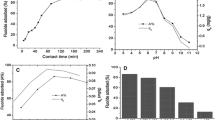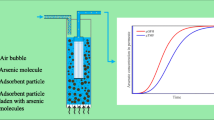Abstract
The potential of mixed alumina-magnesia hydroxide adsorbent (PURAL® MG-20) for defluoridation of drinking water using batch and continuous mode of operations has been reported in the present article. Systematic adsorption experiments were carried out to elucidate the effects of different process parameters such as adsorbent dose, initial fluoride concentration, pH of the solution and effect of other ions (usually present in groundwater). These studies were aimed to understand the adsorption behaviour of the PURAL® MG-20 adsorbents. Fluoride adsorption by PURAL® MG-20 sorbent was found pH dependent. Maximum fluoride removal efficiency was observed in the range of pH 5–7. Langmuir isotherm described the data better than Freundlich and Temkin isotherm models and the adsorption capacity was found to be 5.62 mg g−1 at initial fluoride concentration of 5.13 mg L−1, pH 7 and contact time 24 h. The kinetic result shows that the fluoride sorption follows pseudo-second-order kinetics. Column breakthrough studies were performed to test the performance of the adsorbent media at continuous mode of operation. Thus, it can be concluded that PURAL® MG-20 adsorbent can be used directly for field applications since it shows high fluoride uptake capacity under simulated drinking water conditions and it is also commercially available.











Similar content being viewed by others
Abbreviations
- A T :
-
Temkin isotherm equilibrium binding constant (in litre per milligram)
- B T :
-
Temkin isotherm constant
- C o :
-
Initial concentration of fluoride (in milligram per litre)
- C e :
-
Equilibrium concentration of fluoride ion (in milligram per litre)
- K :
-
Langmuir isotherm constant
- K 1 :
-
Pseudo-first-order rate constant (in per minute)
- K 2 :
-
Rate constant for second-order adsorption (in gram per milligram minute)
- K F :
-
Freundlich constants
- K p :
-
Intraparticle diffusion rate constant (in milligram per gram square root minute)
- m :
-
Weight of adsorbent used per litre of solution (in gram per litre)
- n :
-
Adsorption intensity
- q t :
-
Amount of adsorbate retained at time t (in milligram per gram)
- q e :
-
Adsorption capacity (in milligram per gram) of the solid at equilibrium
- q max :
-
Maximum sorption capacity corresponding to complete monolayer coverage (in milligram per gram)
- V :
-
Volume of the aqueous solution (L)
- W :
-
Mass of the adsorbent (g)
References
Adhikary, S. K., Tipnis, U. K., Harkare, W. P., & Govindan, K. P. (1989). Defluoridation during desalination of brackish water by electrodialysis. Desalination, 71, 301–312.
Arora, M., Maheshwari, R. C., Jain, S. K., & Gupta, A. (2004). Use of membrane technology for portable water production. Desalination, 170, 105–112.
Bhatnagar, A., Kumar, E., & Sillanpää, M. (2011). Fluoride removal from water by adsorption—a review. Chemical Engineering Journal, 171, 811–840.
Diawara, C. K., Lô, S. M., Rumeau, M., Pontie, M., & Sarr, O. (2003). A phenomenological mass transfer approach in nanofiltration of halide ions for a selective defluoridation of brackish drinking water. Journal of Membrane Science, 219, 103–112.
Ghorai, S., & Pant, K. K. (2005). Equilibrium, kinetics and breakthrough studies for adsorption of fluoride on activated alumina. Separation and Purification Technology, 42, 265–271.
Goswami, A., & Purkait, M. K. (2012). The defluoridation of water by acidic alumina. Chemical Engineering Research and Design, 90, 2316–2324.
Jagtap, S., Thakre, D., Wanjari, S., Kamble, S., Labhsetwar, N., & Rayalu, S. (2009). New modified chitosan-based adsorbent for defluoridation of water. Journal of Colloid and Interface Science, 332, 280–290.
Kagne, S., Jagtap, S., Dhawade, P., Kamble, S. P., Devotta, S., & Rayalu, S. S. (2008). Hydrated cement: a promising adsorbent for the removal of fluoride from aqueous solution. Journal of Hazardous Materials, 154, 88–95.
Kamble, S. P., Jagtap, S., Labhsetwar, N. K., Thakare, D., Godfrey, S., Devotta, S., & Rayalu, S. S. (2007). Defluoridation of drinking water using chitin, chitosan and lanthanum-modified chitosan. Chemical Engineering Journal, 129, 173–180.
Kamble, S. P., Dixit, P., Rayalu, S. S., & Labhsetwar, N. K. (2009). Defluoridation of drinking water using chemically modified bentonite clay. Desalination, 249, 687–693.
Kamble, S. P., Deshpande, G., Barve, P. P., Rayalu, S., Labhsetwar, N. K., Malyshew, A., & Kulkarni, B. D. (2010). Adsorption of fluoride from aqueous solution by alumina of alkoxide nature: batch and continuous operation. Desalination, 264, 15–23.
Li, Y. H., Wang, S., Cao, A., Zhao, D., Zhang, X., Xu, C., Luan, Z., Ruan, D., Liang, J., Wu, D., & Wei, B. (2001). Adsorption of fluoride from water by amorphous alumina supported on carbon nanotubes. Chemical Physics Letters, 350, 412–416.
Lounici, H., Belhocine, D., Grib, H., Drouiche, M., Pauss, A., & Mameri, N. (2004). Fluoride removal with electro-activated alumina. Desalination, 161, 287–293.
Maliyekkal, S. M., Sharma, A. K., & Philip, L. (2006). Manganese-oxide-coated alumina: a promising sorbent for defluoridation. Water Research, 40, 3497–3506.
Mameri, N., Yeddou, A. R., Lounici, H., Belhocine, D., Grib, H., & Bariou, B. (1998). Defluoridation of septentrional Sahara water of North Africa by electrocoagulation process using bipolar aluminium electrodes. Water Research, 32, 1604–1612.
Mehta, P. (2012). Impending water crisis in India and comparing clean water standards among developing and developed nations. Archive of Applied Scientific Research, 4, 497–507.
Mjengera, H., & Mkongo, G. (2003). Appropriate defluoridation technology for use in flourotic areas in Tanzania. Physics and Chemistry of the Earth, 28, 1097–1104.
Nawlakhe, W. G., Kulkarni, D. N., Pathak, B. N., & Bulusu, K. R. (1975). Defluoridation of water by Nalgonda Technique. Indian Journal of Environmental Health, 17, 26–65.
Pontie, M., Diawara, C. K., & Rumeau, M. (2003a). Streaming effect of single electrolyte mass transfer in nanofiltration: potential application for the selective defluoridation of brackish drinking waters. Desalination, 151, 267–274.
Pontie, M., Buisson, H., Diawara, C. K., & Essis-Tome, H. (2003b). Studies of halide ions mass transfer in nanofiltration—application to selective defluoridation of brackish drinking water. Desalination, 157, 127–134.
Shen, F., Chen, X., Gao, P., & Chen, G. (2003). Electrochemical removal of fluoride ions from industrial wastewater. Chemical Engineering Science, 58, 987–993.
Wang, S.-G., Ma, Y. S., & Yi-Jing, G. W.-X. (2008). Defluoridation performance and mechanism of nano-scale aluminium oxide hydroxide in aqueous solution. Journal of Chemical Technology and Biotechnology, 84(7), 1043–1050.
Acknowledgments
The authors are thankful to Sasol Germany, GmbH, Hamburg, Germany for supplying free samples of PURAL® MG-20 sorbent.
Author information
Authors and Affiliations
Corresponding author
Rights and permissions
About this article
Cite this article
Patankar, G.V., Tambe, A.S., Kulkarni, B.D. et al. Defluoridation of Drinking Water Using PURAL® MG-20 Mixed Hydroxide Adsorbent. Water Air Soil Pollut 224, 1727 (2013). https://doi.org/10.1007/s11270-013-1727-6
Received:
Accepted:
Published:
DOI: https://doi.org/10.1007/s11270-013-1727-6




